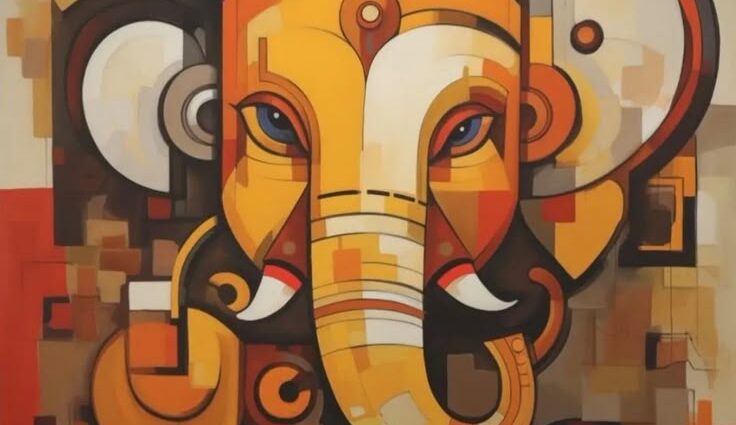This vibrant and captivating painting is a modern, abstract representation of Lord Ganesha, a revered deity in Hinduism, often worshipped as the remover of obstacles and the god of beginnings and wisdom. The artwork blends traditional iconography with a contemporary, cubist-inspired aesthetic.
Key Elements of the Painting:
1. Color Palette
- The dominant hues in this piece are warm oranges, yellows, and reds, contrasted with cooler tones of grey, black, and white.
- The warm colors bring energy and spiritual vibrancy, while the cooler shades offer balance and depth.
2. Cubist Influence
- The painting employs a cubist or geometric abstraction style, with fragmented and overlapping shapes creating a sense of dimensionality and modernity.
- The forms are broken into angular blocks and curved segments, which gives a digital or mosaic-like texture to the traditional subject.
3. Facial Features and Symbolism
- Ganesha’s iconic elephant head, large ears, and curved trunk are central, stylized but unmistakable.
- The eyes are expressive and almond-shaped, appearing almost human-like, which adds a soulful quality.
- The trunk curls elegantly, creating flow and movement amidst the angularity.
- His tusks, one full and one broken (symbolizing imperfection and sacrifice), are depicted in a simplified but effective manner.
- A subtle tilak or spiritual mark is placed on the forehead, reinforcing divine identity.
4. Symmetry and Balance
- The composition is symmetrical, lending a sense of harmony and order—a key element in both sacred art and cubism.
- Despite the abstract style, the symmetry maintains the deity’s recognizable structure, allowing both spiritual and artistic appreciation.
5. Background and Integration
- The background is an extension of the cubist style, composed of layered blocks and muted earth tones, which frame the figure without distracting from it.
- It gives the feeling that Ganesha is emerging from or dissolving into the space, symbolizing the idea of the divine being present everywhere.
Artistic and Cultural Significance:
Such artworks often adorn modern Indian homes, galleries, and even offices, offering both aesthetic pleasure and spiritual comfort.
This painting bridges traditional spirituality and modern art, making it appealing to both devout followers and art enthusiasts.
It reflects a fusion of ancient symbolism with contemporary technique, representing the timelessness and adaptability of cultural icons.
